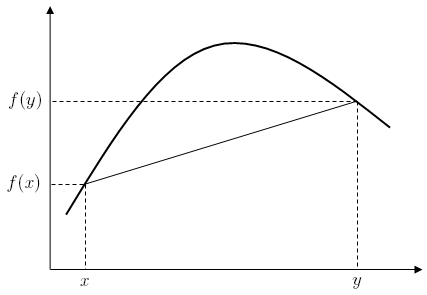Concave function
In mathematics, a concave function is the negative of a convex function. A concave function is also synonymously called concave downwards, concave down, convex upwards, convex cap or upper convex.
Definition
A real-valued function f on an interval (or, more generally, a convex set in vector space) is said to be concave if, for any x and y in the interval and for any α in [0,1],[1]
A function is called strictly concave if
for any α in (0,1) and x ≠ y.
For a function f:R→R, this definition merely states that for every z between x and y, the point (z, f(z) ) on the graph of f is above the straight line joining the points (x, f(x) ) and (y, f(y) ).

A function f is quasiconcave if the upper contour sets of the function are convex sets.[2]:496
Properties
1. A function f is concave over a convex set if and only if the function −f is a convex function over the set.
2. A differentiable function f is concave on an interval if and only if its derivative function f ′ is monotonically decreasing on that interval, that is, : a concave function has a decreasing slope.
3. Points where concavity changes (between concave and convex) are inflection points.
4. The sum of two concave functions is itself concave and so is the pointwise minimum of two concave functions, i.e. the set of concave functions on a given domain form a semifield.
5. Near a local maximum in the interior of the domain of a function, the function must be concave; as a partial converse, if the derivative of a strictly concave function is zero at some point, then that point is a local maximum.
6. If f is twice-differentiable, then f is concave if and only if f ′′ is non-positive (or, if the acceleration is non-positive). If its second derivative is negative then it is strictly concave, but the opposite is not true, as shown by f(x) = −x4.
7. Any local maximum of a concave function is also a global maximum. A strictly concave function will have at most one global maximum.
8. If f is concave and differentiable, then it is bounded above by its first-order Taylor approximation:[2]:489
9. A continuous function on C is concave if and only if for any x and y in C
10. If a function f is concave, and f(0) ≥ 0, then f is subadditive. Proof:
- since f is concave, let y = 0,
Examples
- The functions and are concave on their domains, as their second derivatives and are always negative.
- The logarithm function is concave on its domain , as its derivative is a strictly decreasing function.
- Any affine function is both concave and convex, but not strictly-concave nor strictly-convex.
- The sine function is concave on the interval .
- The function , where is the determinant of a nonnegative-definite matrix B, is concave.[3]
- Practical example: rays bending in computation of radiowave attenuation in the atmosphere.
See also
- Concave polygon
- Convex function
- Jensen's inequality
- Logarithmically concave function
- Quasiconcave function
References
- ↑ LENHART, S.; WORKMAN, J. T, Optimal Control Applied to biological models, Chapman & Hall/ CRC, Mathematical and Computational Biology Series, 2007.
- 1 2 Varian, Hal (1992). Microeconomic Analysis (Third ed.). New York: Norton. ISBN 0393957357.
- ↑ Thomas M. Cover and J. A. Thomas (1988). "Determinant inequalities via information theory". SIAM Journal on Matrix Analysis and Applications. 9 (3): 384–392. doi:10.1137/0609033.
Further References
- Crouzeix, J.-P. (2008). "Quasi-concavity". In Durlauf, Steven N.; Blume, Lawrence E. The New Palgrave Dictionary of Economics (Second ed.). Palgrave Macmillan. doi:10.1057/9780230226203.1375.
- Rao, Singiresu S. (2009). Engineering Optimization: Theory and Practice. John Wiley and Sons. p. 779. ISBN 0-470-18352-7.